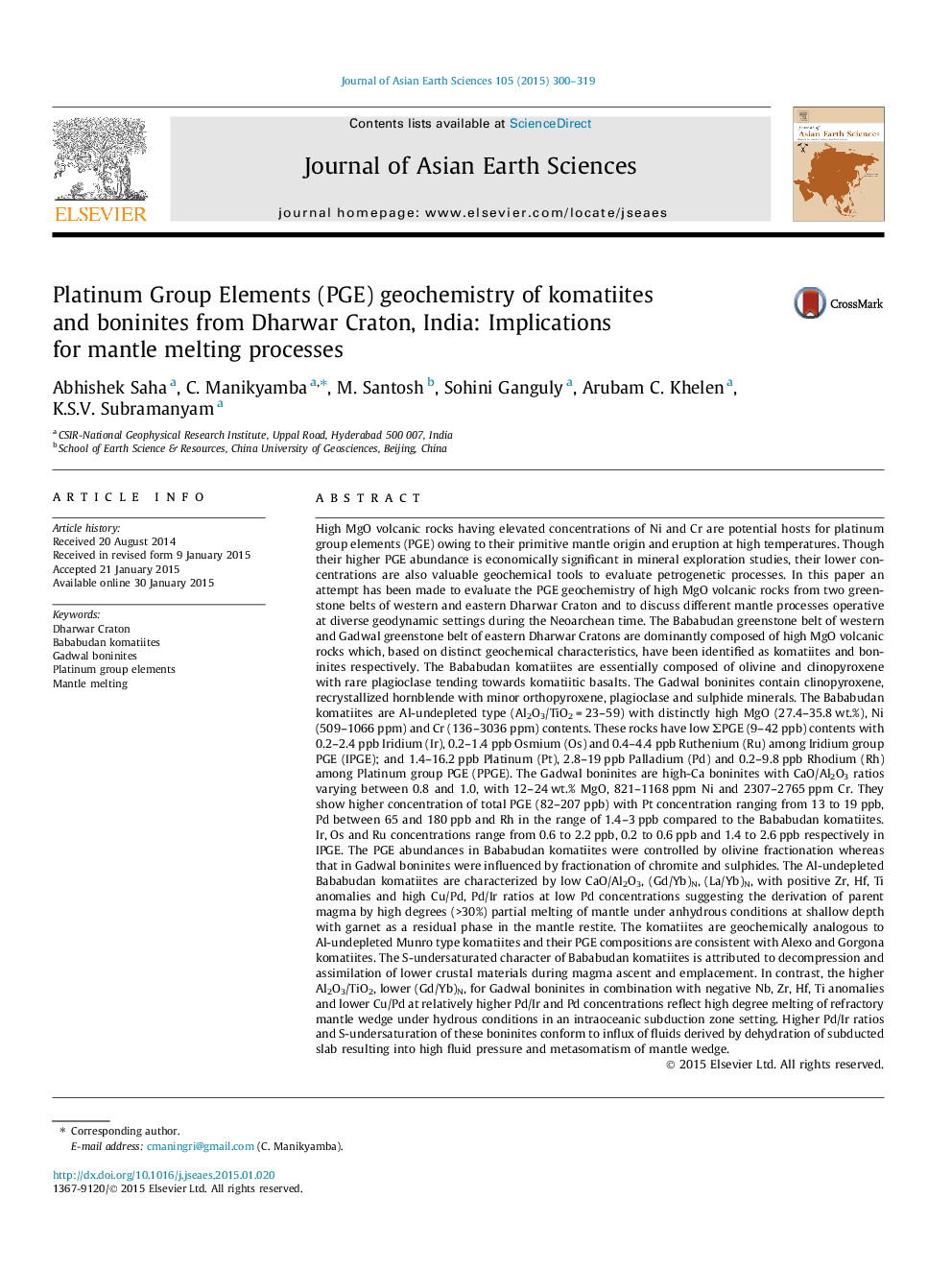| کد مقاله | کد نشریه | سال انتشار | مقاله انگلیسی | نسخه تمام متن |
|---|---|---|---|---|
| 4730500 | 1640364 | 2015 | 20 صفحه PDF | دانلود رایگان |

• PGE abundances of komatiite and boninite reflect olivine, chromite, sulphide fractionation.
• Komatiites generated by ⩾30% anhydrous melting of upwelling hot mantle in intraplate setting.
• Boninites formed by hydrous melting of metasomatized mantle wedge in subduction environment.
• S-undersaturation controlled by different mantle processes at diverse tectonic regimes.
High MgO volcanic rocks having elevated concentrations of Ni and Cr are potential hosts for platinum group elements (PGE) owing to their primitive mantle origin and eruption at high temperatures. Though their higher PGE abundance is economically significant in mineral exploration studies, their lower concentrations are also valuable geochemical tools to evaluate petrogenetic processes. In this paper an attempt has been made to evaluate the PGE geochemistry of high MgO volcanic rocks from two greenstone belts of western and eastern Dharwar Craton and to discuss different mantle processes operative at diverse geodynamic settings during the Neoarchean time. The Bababudan greenstone belt of western and Gadwal greenstone belt of eastern Dharwar Cratons are dominantly composed of high MgO volcanic rocks which, based on distinct geochemical characteristics, have been identified as komatiites and boninites respectively. The Bababudan komatiites are essentially composed of olivine and clinopyroxene with rare plagioclase tending towards komatiitic basalts. The Gadwal boninites contain clinopyroxene, recrystallized hornblende with minor orthopyroxene, plagioclase and sulphide minerals. The Bababudan komatiites are Al-undepleted type (Al2O3/TiO2 = 23–59) with distinctly high MgO (27.4–35.8 wt.%), Ni (509–1066 ppm) and Cr (136–3036 ppm) contents. These rocks have low ΣPGE (9–42 ppb) contents with 0.2–2.4 ppb Iridium (Ir), 0.2–1.4 ppb Osmium (Os) and 0.4–4.4 ppb Ruthenium (Ru) among Iridium group PGE (IPGE); and 1.4–16.2 ppb Platinum (Pt), 2.8–19 ppb Palladium (Pd) and 0.2–9.8 ppb Rhodium (Rh) among Platinum group PGE (PPGE). The Gadwal boninites are high-Ca boninites with CaO/Al2O3 ratios varying between 0.8 and 1.0, with 12–24 wt.% MgO, 821–1168 ppm Ni and 2307–2765 ppm Cr. They show higher concentration of total PGE (82–207 ppb) with Pt concentration ranging from 13 to 19 ppb, Pd between 65 and 180 ppb and Rh in the range of 1.4–3 ppb compared to the Bababudan komatiites. Ir, Os and Ru concentrations range from 0.6 to 2.2 ppb, 0.2 to 0.6 ppb and 1.4 to 2.6 ppb respectively in IPGE. The PGE abundances in Bababudan komatiites were controlled by olivine fractionation whereas that in Gadwal boninites were influenced by fractionation of chromite and sulphides. The Al-undepleted Bababudan komatiites are characterized by low CaO/Al2O3, (Gd/Yb)N, (La/Yb)N, with positive Zr, Hf, Ti anomalies and high Cu/Pd, Pd/Ir ratios at low Pd concentrations suggesting the derivation of parent magma by high degrees (>30%) partial melting of mantle under anhydrous conditions at shallow depth with garnet as a residual phase in the mantle restite. The komatiites are geochemically analogous to Al-undepleted Munro type komatiites and their PGE compositions are consistent with Alexo and Gorgona komatiites. The S-undersaturated character of Bababudan komatiites is attributed to decompression and assimilation of lower crustal materials during magma ascent and emplacement. In contrast, the higher Al2O3/TiO2, lower (Gd/Yb)N, for Gadwal boninites in combination with negative Nb, Zr, Hf, Ti anomalies and lower Cu/Pd at relatively higher Pd/Ir and Pd concentrations reflect high degree melting of refractory mantle wedge under hydrous conditions in an intraoceanic subduction zone setting. Higher Pd/Ir ratios and S-undersaturation of these boninites conform to influx of fluids derived by dehydration of subducted slab resulting into high fluid pressure and metasomatism of mantle wedge.
Journal: Journal of Asian Earth Sciences - Volume 105, 1 June 2015, Pages 300–319